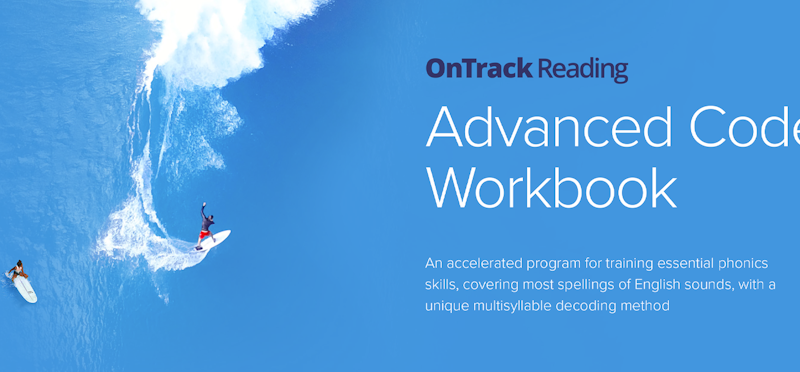
The vast majority of popular methods used to teach a child to decode multisyllable words are confusing and ineffective. This includes well-known strategies like the six-syllable method and the prefix/suffix method. These approaches teach a child to jump around in a long word, looking for clues, then go back to the beginning and use the clues to piece the word together. It's a process that leads to confusion, not understanding.
Most methods also cling too tightly to the syllable structure that Noah Webster settled on over two hundred years ago. This reliance on outdated structures directly hinders learning progress.
A Better Way: Left to Right, in a Consistent Way Every Time
The OnTrack Reading Multisyllable Method teaches a child to start at the beginning of a long, unfamiliar word and divide it into chunks, stopping each chunk after the vowel sound. Using the phonics knowledge they learned while working on one-syllable words, they apply the First Vowel Sound to each of the chunks.
The First Vowel Sound is either the short sound of the letters a, e, i, o, and u, or the most likely option in all other vowel spellings. Of course, they have to have been taught, during one-syllable work, what the most likely options are for vowel spellings like ow, ea, ie, ou, y, oa, ew, ue, and several more. As you will soon see, they have to also be taught the other options.
For example, they need to know that the three sounds of the letter a are the /a/ sound in cat, the /ae/ sound in table and the /o/ sound in want. Similarly, they must know that the two sounds of the vowel digraph ow are the /ow/ sound in how and the /oe/ sound in grow.
But That Sounds Like a Lot to Teach Before Multisyllable Instruction...
Of course it does. OnTrack Reading uses a 170-page workbook to teach the advanced phonics code thoroughly. It starts after a child already knows the basic code, meaning the one-letter to one-sound part of the code, such as the /a/ sound in cat and the /m/ sound in man. Of the 170 pages of advanced code work, only eighteen pages are devoted to the multisyllable method. That's just over 10% of the entire advanced code curriculum.
The point is: To read long words easily and accurately, a child must know the phonics code in one-syllable words. They don't have to know it completely – the Multisyllable Method we teach helps build a child‘s code knowledge as they use it. But they need to know the most likely option for nearly all of the vowel and consonant spellings they will encounter.
Comparing One Popular Method With OnTrack Reading's Method
One method, which we can call the prefix-suffix-root method, teaches a child to identify any prefixes and suffixes in a long word. Then the child inspects what‘s left, presumably the root. Let's try that on a few words from the four-syllable section of the workbook:
- circulatory - Is there really a useful prefix or suffix present, one that a child should know? No, but if he's taught to chunk it after each vowel sound, he gets cir-cu-la-tor-y. Oops, that's a five-syllable word. Well, let's see how it goes. If he tries the First Vowel Sounds, his first pass was accurate on the first, fourth, and fifth chunks. (That implies, of course, that he used the /s/ sound for cir and the /k/ sound for cu which is why the Rule-of-c is taught midway through the one-syllable curriculum.) Now, remember that the child isn't jumping around in the word looking for elements he might recognize. No, he's just said "cir-cu-la-tor-y" but the cu chunk sounds like cut without the t and the la chunk sounds like lad without the d. Try that yourself, say "cir-cu-la-tor-y" as I've described it. Odds are fair that even if you've never seen the word in print, you will recognize it if you're already familiar with the word in your oral vocabulary. But that's not the end of the process. If he doesn't yet recognize the word, he's been taught to leave the first chunk unchanged as cir (because the /er/ sound is the only option he's been taught for the ir digraph) and address the second chunk. The second option for the letter u is the /ue/ sound in unit. Now he gets "cir-cue-la-tor-y" and odds are he either gets it on that pass (despite mispronouncing la) or the word isn't in his oral vocabulary yet.
- evaporate - Again, no useful prefix or suffix, but maybe he sees vapor and can do something with that? It's not particularly helpful though because the sound of the letter a is the wrong one. Meanwhile, the child trained in our method gets e-va-por-ate on the first pass, puts it together and gets the word on the first pass because all of the vowel spellings use their First Vowel Sounds, that is, the ones the child has been taught to use first.
- denominator - The prefix-suffix-root-trained child picks out de and maybe or and, after jumping back and forth in the word, tries to find a root somewhere, while a child using the OnTrack Reading method says de-no-mi-na-tor, with only the na chunk incorrect. If he's reading a math problem and has the word established in his oral vocabulary, the word denominator is likely to come to mind, and when he goes back through the printed word, he sees that it fits if he just changes the vowel letter a to its Second Vowel Sound.
- trigonometry - Prefix-suffix-root child sees the prefix tri which does him no good because it's got the wrong sound assigned to the letter i, and struggles from there. Our child goes tri-go-no-me-try and hits it on the nose on the first pass. Even though he's never heard the word, he might say "trigonometry?" and be assured by someone else that he's right.
But You Hand-Picked Words That Worked with Your Method...
Yes, I did, but for a different reason than you might be thinking. You see, stopping each chunk after the vowel sound is the Main Rule of the method. Additionally, there are three very easy-to-teach Exceptions to the Main Rule. In four-syllable words, the one most used is the Third Exception, which states: “Add a sound to the chunk if the next chunk is 'Hard to Say.'”
English words only start with certain consonant blends, like br, bl, dr, spr, etc. Awkward blends are referred to as illegal blends. They are also quite difficult to enunciate, or to put it in kid's language, they‘re “hard to say.”
So, here are a few words illustrating how a child trained in both the Main Rule and the Third Exception will tackle an unfamiliar long word:
- combination - (The prefix-suffix-trained child might get this one.) Using our method, a child will say co, then run into mbi and realize that the mb blend is awkward, i.e., that it's "hard to say" and will, as instructed, move the letter m to the previous chunk, getting com. He will the add bi-na-tion, getting com-bi-na-tion, mispronouncing only the na chunk (unless he's already seen enough words ending in ation to know that the letter a in that circumstance is nearly always pronounced with the Second Vowel Sound, in which case he'll get the word on the first pass. But he's also been taught another important thing about the chunk com. By moving the letter m, he's more than likely "locked in" the vowel sound in that chunk as being the First Vowel Sound. He isn't told this, but essentially he's created a closed syllable by moving the letter m.
- activity - Our child will start with a-cti, realize he has to move the letter c and end up with ac-ti-vi-ty, pronouncing it correctly on the first pass.
- electrical - He will start with e-le-ctri, then move the letter c to end up with e-lec-tri-cal. He might get it immediately, but if he doesn't, he's instructed to try the Second Vowel Sound in chunks that weren't modified by one of the Three Exceptions. He tries the /ee/ sound for the first chunk and almost certainly recognizes the word by then.
- opportunistic - This one uses the First Exception: Add a doubled consonant to the chunk. So, our child starts with o-ppor sees the doubled p and, as instructed, moves it to the previous chunk. Now he has opp-or-tu-ni-stic. He's learned that moving the doubled consonant tends to lock in the chunk, and the or chunk might be /or/ or /er/, tries /er/ and still doesn't recognize the word (because he's using the /u/ sound in the third chunk). As instructed, he moves his focus to that chunk and tries the Second Vowel Sound, /ue/. At that point, he recognizes opportunistic but checks it closely again and realizes that he's actually saying the Third Sound, /oo/, for the letter u. He also decides, for future spelling purposes to think of the second chunk as "or" rather than "er" even though it sort of sounds more like "er." He also might make a mental note that it's more awkward to say op-er-tu-ni-stic than it is to say o-per-tu-ni-stic, so if he continues to chunk it that way he might remember that he's doing that because the letter p is doubled, another spelling tip. So, if he recalls the word as "opp-or-tu-ni-stic" when he spells it, he'll remember both tricky parts, the doubled pp and the or spelling of the /er/ sound.
The Six-Syllable Method So Popular Today
I‘ve decided to cut that discussion down to two questions: How many readers actually used that method to learn to read multisyllable words? For that matter, how many of you can even list the six syllable types? My guess is near zero in both cases, unless you taught the method yourself. Essentially, four of the six types just mean “learn the code,” and the other two require pre-knowledge of what the vowel sound is to apply them.
Summing Up
The current state of multisyllable instruction is very flawed, mostly because the methods rely on the concept of a syllable. The most popular approaches have children jumping around in the word, expecting them to use rules they don't apply, or find word parts that are misleading as often as they are helpful.
Young readers need two things to successfully decode long words. First, they must have a solid understanding of the advanced phonics code, including the various sounds that a letter or digraph can represent, especially when it can signify more than one sound. Second, they need to be taught a method that enables them to march through a long word from left to right, systematically applying the code knowledge they've learned, and then adjusting their choices until they recognize a word in their oral vocabulary.
The OnTrack Reading Multisyllable Method takes care of the second requirement and is available free here on the website. The Advanced Code Phonics Workbook addresses both requirements. Together, these methods empower young readers with the tools they need to read long words confidently and accurately.




